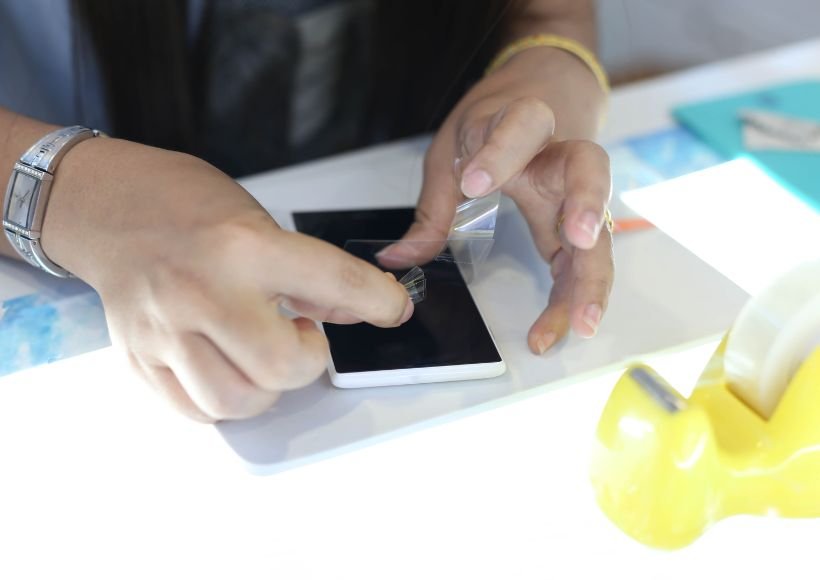Choosing The Right Screen Protector for Your Mobile Phone

When purchasing a mobile phone, whether new or second-hand, it’s crucial to protect it to prolong its useful life. The first accessories you should consider are a case and a screen protector.
This article highlights the importance of selecting the right screen protector and provides information on the various types available. Take advantage of this valuable guide to simplify your decision-making process.
Table of Contents
How to choose a suitable screen protector
A screen protector is a vital accessory for your mobile device, consisting of a transparent and durable layer that adheres to the screen. Its primary function is to safeguard the screen from cracks and scratches caused by accidental drops or impacts.
The screen holds significant importance as a delicate component of your smartphone. Any damage to it can render the device unusable. Screen breakage ranks among the most frequent issues encountered by mobile technical services.
When choosing a screen protector for your mobile, you must take into account the following criteria
When it comes to screen protectors, there are various factors to consider, such as the material of manufacture, thickness, type of coverage, and transparency level.
The protectors are typically made from polyethylene terephthalate (PET), tempered glass, InvisiGlass Ultra, or UltraGlass. They vary in thickness, ranging from 0.2 to 0.45 millimeters. It’s important to note that a thicker protector doesn’t necessarily mean it’s more resistant. The resistance depends on the composition and the manufacturer. The thickness should be considered in terms of usability and aesthetics, as thicker protectors may have more significant edges.
Regarding coverage, some flat protectors cover only the screen’s active area, and curved protectors provide maximum coverage from edge to edge.
The transparency level is another important aspect. Most screen protectors offer over 95% transparency. Some protectors have a multilayer structure, while others feature anti-reflective surfaces with a matte coating, making it difficult to read from afar.
To provide comprehensive protection, it’s recommended to pair the screen protector with a case that has thick edges to safeguard the device from side impacts.
Considering these characteristics, the most common types of screen protectors can be categorized accordingly.
Check this Article : Smartphone Repair
Types of screen protectors
There are several types of screen protectors available on the market. Here are some common ones:
PET Screen Protectors
These are made from polyethylene terephthalate (PET) material. They are lightweight and provide basic protection against scratches and minor impacts. PET protectors have good clarity and are usually affordable.
Tempered Glass Screen Protectors
Tempered glass protectors offer excellent protection against scratches, cracks, and impacts. They are thicker and more durable than PET protectors. Tempered glass protectors maintain the touch sensitivity and clarity of the device’s screen and are available in various levels of hardness and thickness.
Liquid Screen Protectors
Liquid screen protectors consist of a thin, liquid-based solution applied to the screen and left to dry. Once dried, they form an invisible layer that helps prevent scratches. However, they may offer a different level of protection than tempered glass protectors.
Privacy Screen Protectors
Privacy screen protectors feature a special filter that narrows the viewing angle, making it difficult for others to see the screen content from the sides. This protects your privacy and is particularly useful in crowded spaces or public settings.
Anti-Glare Screen Protectors
Anti-glare protectors have a matte coating that reduces glare and reflections, making viewing the screen in bright environments or under direct sunlight easier. They are useful for enhancing visibility and reducing eye strain.
Full Coverage Screen Protectors
Full coverage protectors are designed to cover the entire front surface of the device, including the curved edges. They provide comprehensive protection against scratches and impacts and are commonly used for smartphones with edge-to-edge displays.
These are just a few examples of the types of screen protectors available. It’s essential to consider your specific needs and preferences when selecting the most suitable protector for your device.
Gel or Hydrogel screen protector
Gel or hydrogel screen protectors are a type of screen protection that utilizes a gel-like material to safeguard the device’s screen. They are typically made from a combination of polymers and additives, providing flexibility and self-healing properties.
Hydrogel protectors offer several advantages. They have excellent impact resistance, absorbing and dispersing the force from accidental drops or impacts. The self-healing properties allow minor scratches or marks to disappear, maintaining the screen’s clarity.
Furthermore, gel or hydrogel protectors are often easy to install as they can be applied without adhesive need. They adhere to the screen through static cling or a water-based solution, ensuring a bubble-free installation.
It’s important to note that gel or hydrogel protectors may not offer the same hardness level as tempered glass protectors, making them more susceptible to deeper scratches or punctures. However, they protect against daily wear and tear while maintaining a smooth and responsive touch experience.
Conclusion
Choosing the right screen protector is crucial for prolonging the useful life of your mobile devices. When selecting, consider factors such as material, thickness, coverage type, and transparency level. Options like tempered glass, PET, or hydrogel offer varying levels of protection and features.
Remember to pair your screen protector with a suitable case for comprehensive device protection. Considering these factors will help you make an informed decision and safeguard your screen from scratches, cracks, and other damages, ensuring a longer lifespan for your mobile phone.
Also Read : Best-Selling Mobile Brands In Recently

I don’t think the title of your article matches the content lol. Just kidding, mainly because I had some doubts after reading the article.